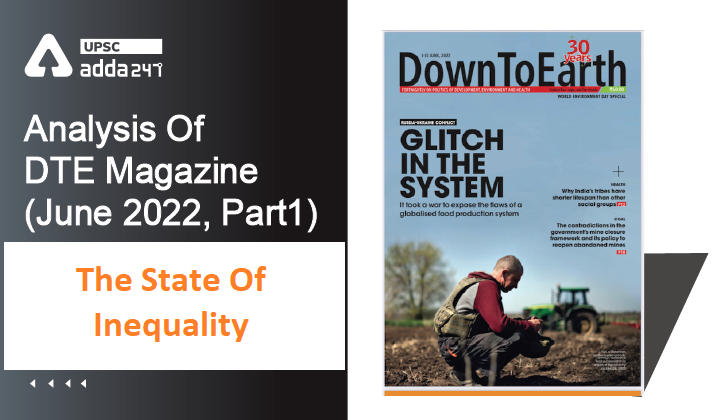Table of Contents
Analysis of Down to Earth Magazine: The State Of Inequality
Introduction
- The State of Inequality in India Report has released by Economic Advisory Council to the Prime Minister (EAC-PM).
- The report has been written by the Institute for Competitiveness and presents a holistic analysis of the depth and nature of inequality in India.
About State of Inequality in India Report
- Consisting of two parts – Economic Facets and Socio-Economic Manifestations – the report looks at five key areas that influence the nature and experience of inequality.
- These are income distribution and labour market dynamics, health, education and household characteristics. Based on the data derived from various rounds of the Periodic Labour Force Survey (PLFS), National Family and Health Survey (NFHS) and UDISE+, each chapter is dedicated to explaining the current state of affairs, areas of concern, successes and failures in terms of infrastructural capacity and finally, the effect on inequality.
- The report stretches the narrative on inequality by presenting a comprehensive analysis that shapes the ecosystem of various deprivation in the country, which directly impacts the well-being of the population and overall growth.
- It is a study that cuts across the intersections of class, gender, and region and highlights how inequality affects the society.
State of Inequality Report on Income Inequality
- According to the state of inequality report by the Institute for Competitiveness, an Indian bringing in a monthly wage of R 25,000 is among the top 10 per cent of earners in the country.
- The share of the top 1% accounts for 6-7% of the total incomes earned, while the top 10% accounts for one-third of all incomes earned.
- The report, as if to dissuade a deep dive into the data, adds a cautionary note: “If an amount like this comes in the top 10 percentile, then the bottom-most condition cannot be imagined.”
- This study, commissioned by the Economic Advisory Council to the Prime Minister, shows the wide chasm between the top and bottom earners.
- This gap is getting wider: while the income of the top 1 per cent of earners grew by 15 per cent in 2017-18 and 2019-20, that of the bottom 10 per cent earners fell by 1 per cent.
- This is a “failure of the trickle-down approach to economic growth,” says the report. So, if wealth is not trickling down, what happens to those at the bottom of the pyramid? Will they ever reach the peak, or even the top 10 per cent bracket (with the R25,000-a-month level)?
The World Inequality Report 2022
- According to World Inequality Report 2022, India stands out as a poor and very unequal country, with an affluent elite.
- Over 50 per cent of India’s population is without any significant wealth.
- Just like the wealth that a billionaire’s children inherit serves as their critical capital to pursue prosperity, the progress of the children of those without wealth is stifled in absence of inheritance. “People accumulate wealth across generations through inheritance. It has a snowball effect. This is why the rich section’s wealth grows faster.
- While the income of India’s top 1% earners grew by 15% in 2017-18 and 2019-20, that of the bottom 10% earners fell by 1%
Impact of Rising Food Inflation on Income Inequality
- The rate of food inflation has more than doubled in the last one year.
- A recent World Bank estimate shows that one percentage rise in food prices will push 10 million people into extreme poverty.
- These are the people at the bottom of the income pyramid.
- The fact that their number is growing under severely unfavourable conditions means they will never be able to bridge the income gap.
Conclusion
The information available on inequality, which this report brings out, will help formulate reform strategies, a roadmap for social progress and shared prosperity.



 TSPSC Group 1 Question Paper 2024, Downl...
TSPSC Group 1 Question Paper 2024, Downl...
 TSPSC Group 1 Answer key 2024 Out, Downl...
TSPSC Group 1 Answer key 2024 Out, Downl...
 UPSC Prelims 2024 Question Paper, Downlo...
UPSC Prelims 2024 Question Paper, Downlo...
